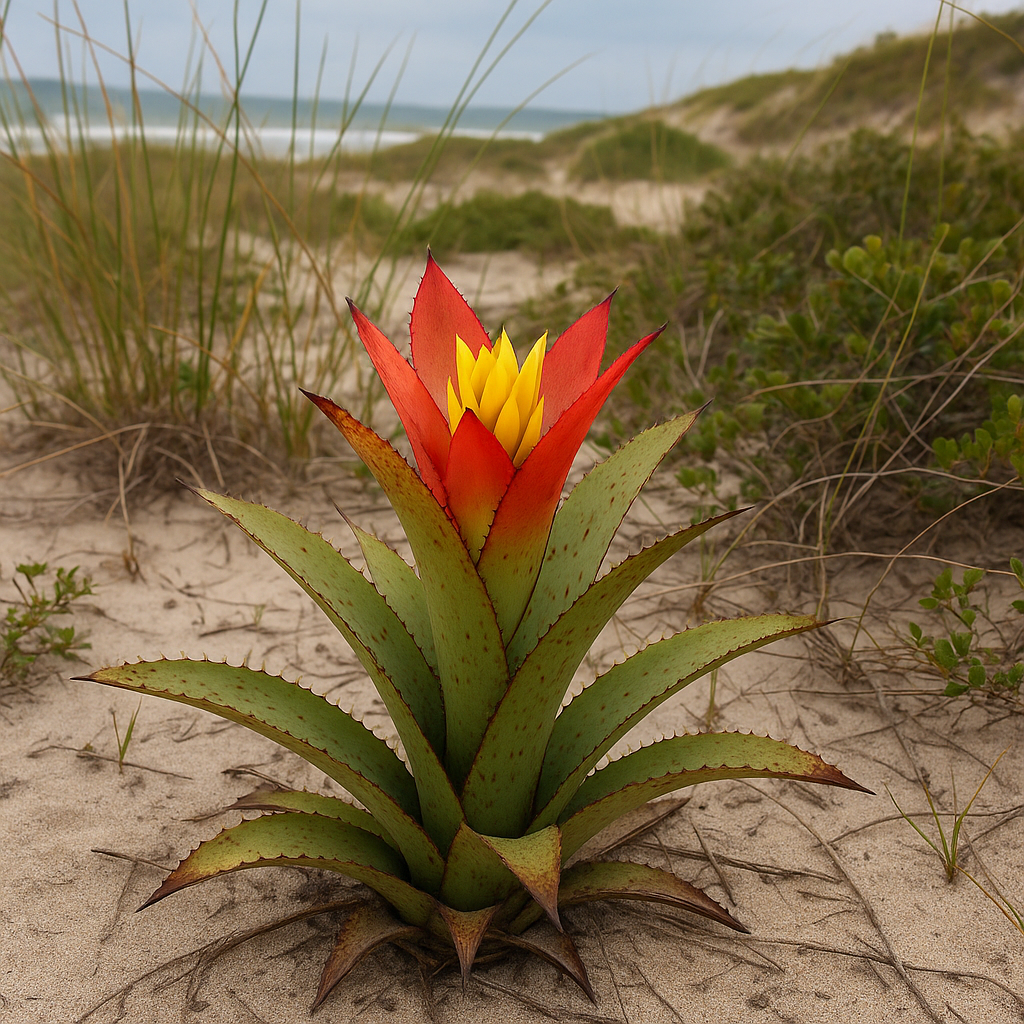What is the Restinga Bromeliad?
The restinga bromeliad is a plant typical of Brazil’s coastal ecosystems, especially in restinga areas, a type of vegetation that thrives on sandy soils near the sea. Belonging to the Bromeliaceae family, this plant is known for its resistance to heat, wind, and salinity—distinct characteristics of coastal zones.
The name “restinga bromeliad” may refer to several species of bromeliads adapted to this habitat, such as Neoregelia cruenta and Aechmea nudicaulis, two of the most common along the southeastern coast of Brazil.
Plant Characteristics
The restinga bromeliad grows in a rosette shape, with thick, rigid leaves that often have spiny edges. The colors range from light green to grayish-green, with red hues on the tips or in the floral bracts.
These plants can store water in their leaves, forming small reservoirs that serve as habitats for insects, frogs, and even small crustaceans. This micro-ecosystem helps maintain biodiversity in restinga environments.
Adaptation to the Environment
One of the reasons the restinga bromeliad stands out is its impressive ability to survive in harsh conditions. The sandy, nutrient-poor soil would be a challenge for many plants, but bromeliads have evolved several adaptations, such as:
- Short roots used more for anchoring than for absorption;
- Nutrient and water absorption through the leaves;
- Resistance to constant wind and salty air.
Ecological Importance
The restinga bromeliad is not just a decorative element of nature—it plays a crucial role in environmental balance. By providing shelter and water for many species, it contributes to the maintenance of local fauna.
It also helps prevent soil erosion, as its roots aid in fixing the sand, especially on dunes and transitional areas between beach and forest. Its presence supports the stability of the entire restinga ecosystem.
Where to Find It
This bromeliad is common along the Brazilian coast, especially in Rio de Janeiro, Espírito Santo, São Paulo, and parts of southern Bahia. It can be found in protected areas such as ecological parks and also in privately owned coastal lands.
With increasing urban development in coastal regions, many restinga habitats are under threat, putting native bromeliads at risk.
Cultivation and Ornamental Use
Although native to wild ecosystems, restinga bromeliads can be grown in gardens, particularly in tropical or native landscaping projects. To cultivate them successfully, it’s important to simulate their natural habitat:
- Well-drained, sandy soil;
- Moderate to full sun exposure;
- Controlled watering—avoid soaking the base, but keep the central reservoir moist.
Thanks to their exotic beauty and hardiness, these bromeliads are ideal for coastal gardens, outdoor pots, or even hanging baskets. Their vibrant appearance also attracts butterflies and hummingbirds, enhancing any garden.
Threats and Conservation
The main threat to restinga bromeliads is uncontrolled urbanization and the destruction of natural areas for construction and infrastructure. While some species are not currently endangered, habitat loss directly impacts their population.
Fortunately, conservation initiatives are gaining momentum. Restoration projects in restinga areas and coastal reforestation efforts are increasingly incorporating native species, including bromeliads, to restore degraded ecosystems.
Fun Facts
- Some restinga bromeliads change color at the tips of their leaves to attract pollinators.
- Their flowers usually bloom in the center and can last for several weeks.
- Even after flowering, the mother plant can produce side shoots, allowing natural propagation.
Conclusion
The restinga bromeliad is a true symbol of resilience and natural beauty. Adapted to coastal environments, it plays a vital role in preserving biodiversity and protecting fragile sandy soils. At the same time, it enchants with its vibrant structure, making it a great choice for combining landscaping with ecological awareness.
If you live near the coast or want to create a garden with native and hardy species, consider adding the restinga bromeliad to your project.


